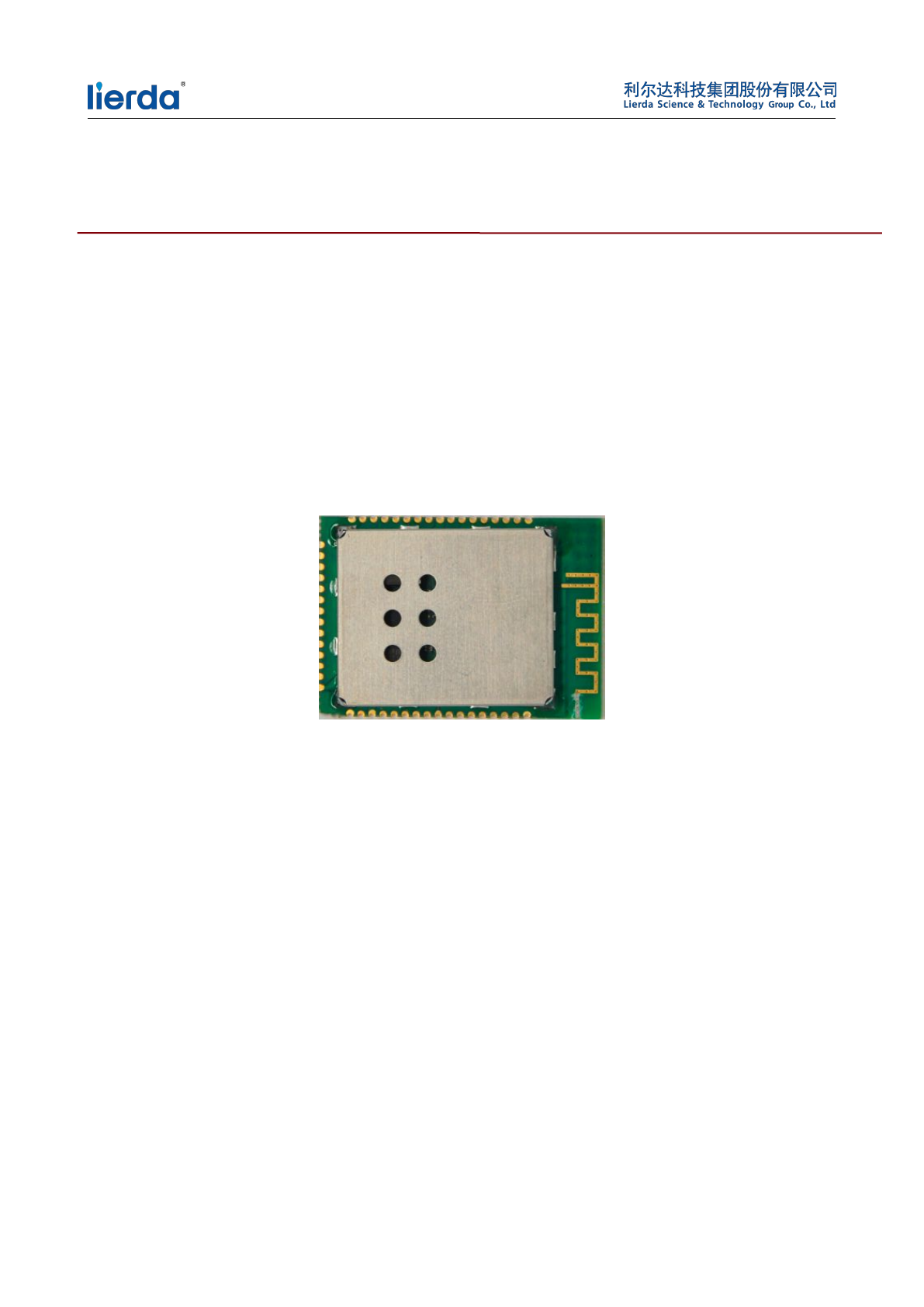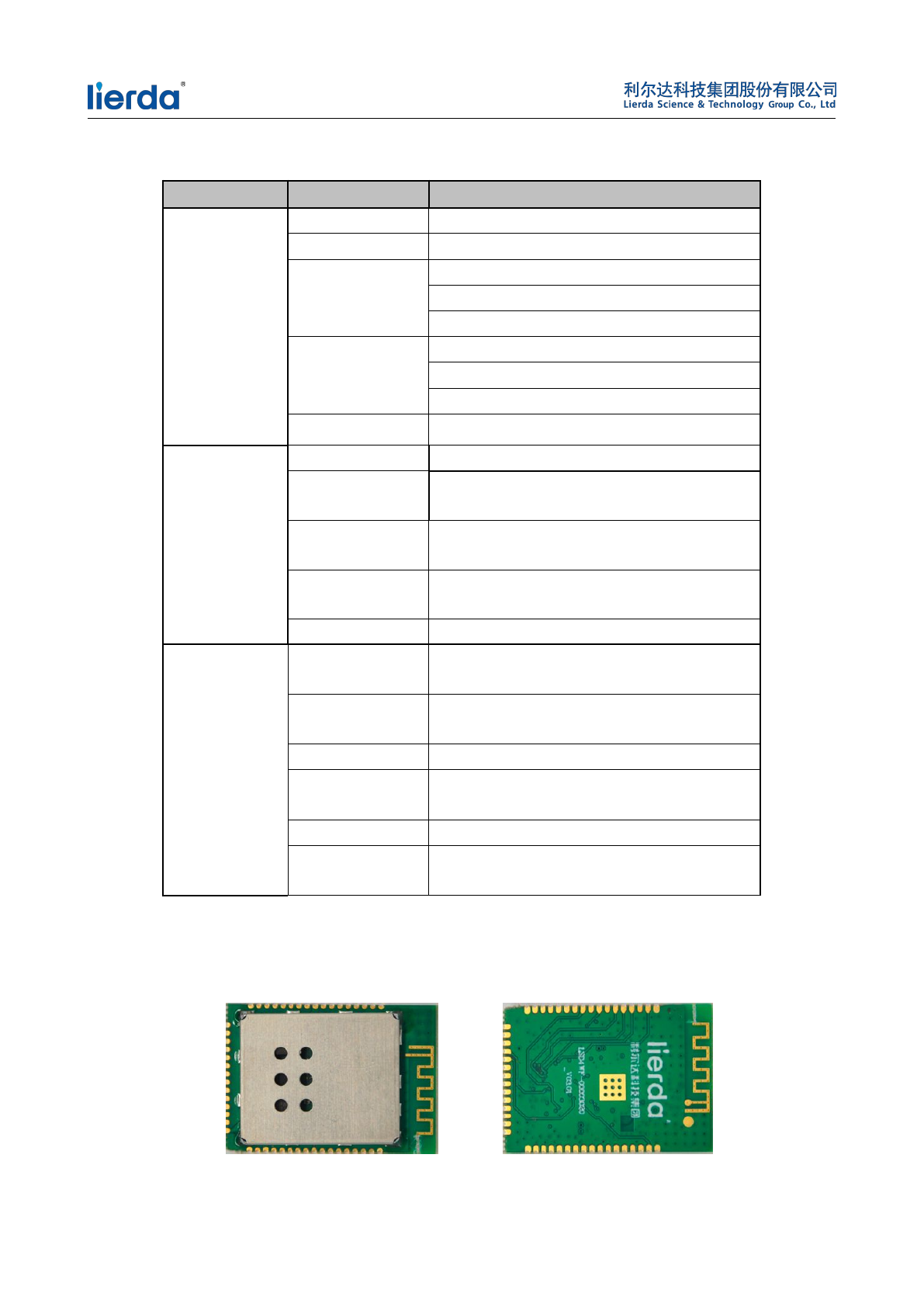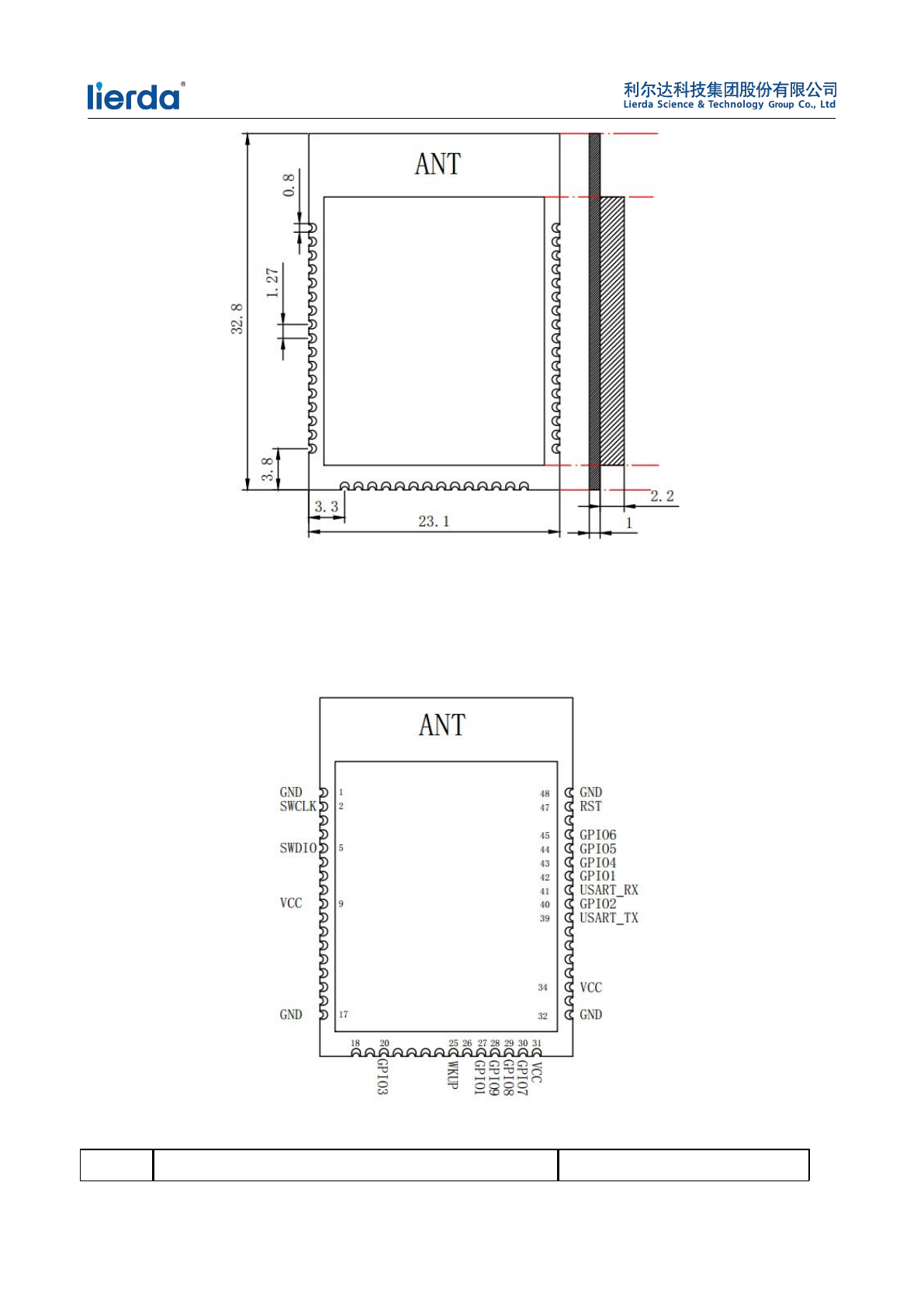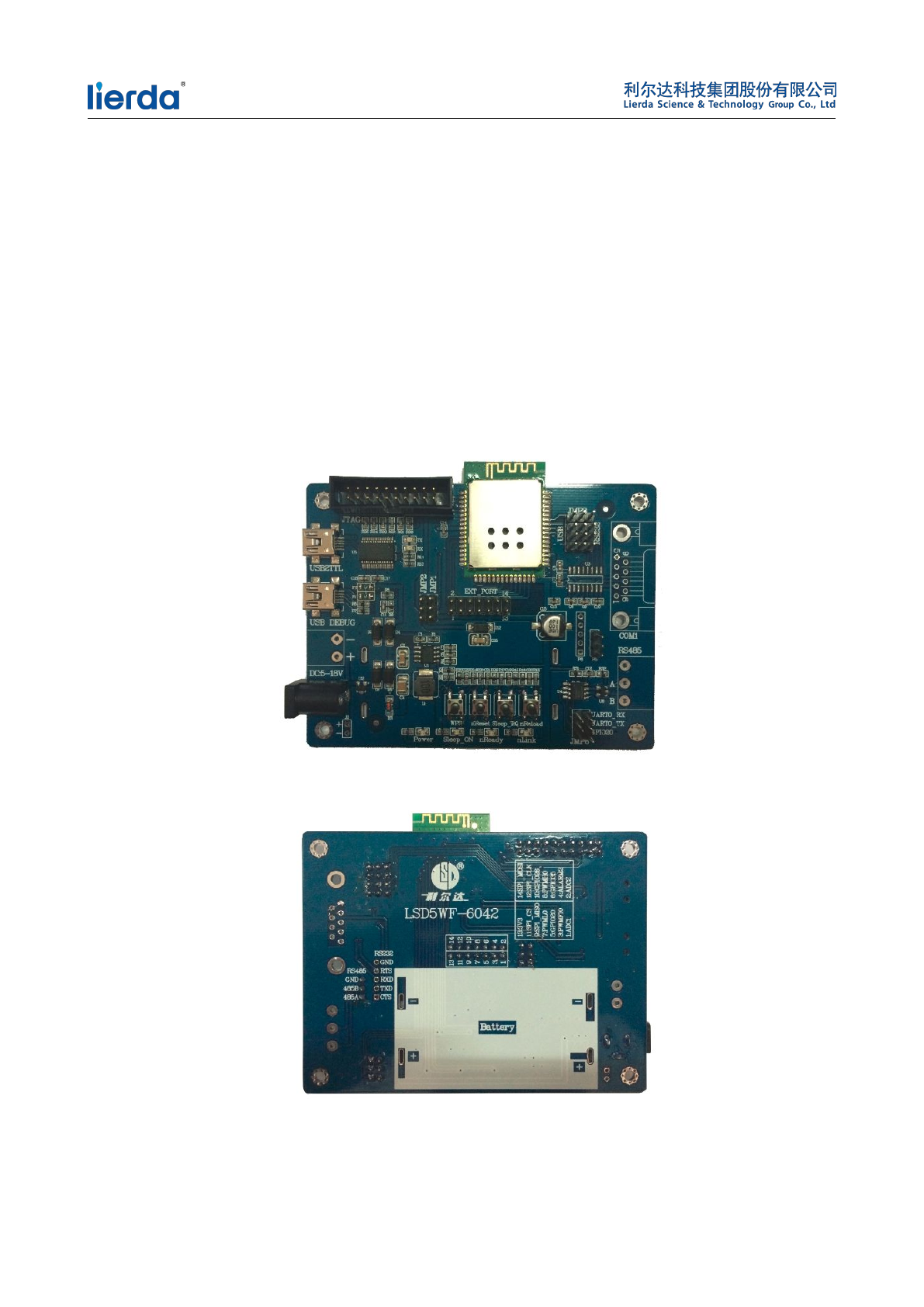Lierda Science and Technology Group LSD4WF WiFi Module User Manual
Lierda Science & Technology Group Co.,Ltd WiFi Module
User Manual

Lierda Science & Technology Ltd
LSD SCIENCE & TECHNOLOGY CO., LTD.
LSD4WF-2MD05101
Low Power Wi-Fi Module User Manual
Model :LSD4WF-2MD05101
Name :Wi-Fi Module
Revision :v1.0
FCC ID:N8NLSD4WF

Index
1. Product overview.................................................................................................................................................3
1.1 General Description..................................................................................................................................3
1.2 Features........................................................................................................................................................3
2. Parameters.............................................................................................................................................................4
3. Package.................................................................................................................................................................. 4
4. Pin definition.........................................................................................................................................................5
5. Behavior of electricity.........................................................................................................................................6
6. Typical application...............................................................................................................................................7
7. Reference design................................................................................................................................................. 7
8. Developing tool................................................................................................................................................... 8

1. Product overview
1.1 General Description
LSD4WF-2MD05101 is a Wi-Fi module for any electronic device to achieve networking
capabilities. The module is fully in line with the 802.11b/g/n international standard specification, the
internal integrated high performance Cortex M4 and Wi-Fi chip make it easy to access the serial port
equipment or MCU control equipment to network, so as to realize wireless networking.
Built-in TCP/IP protocol stack, supports STA/AP/STA+AP coexistence working modes, supports
802.11b/g/n protocol, supports wireless local upgrade and OTA remote firmware upgrade.
32.8mmx23.1mmx3.2mm, using the stamp hole package, built-in board PCB antenna.
1.2 Features
Confirm with 802.11b/g/n protocol.
Built-in high performance M4 core MCU, highest frequency 100MHz, high speed data
processing ability.
USART/GPIO/SPI/PWM multiple interface.
QJoine high speed link configuration.
Support STA/AP/STA+AP coexist work mode.
Support WPA/WPA2/WEP encryption.
Support wireless, Web page and OTA remote hardware upgrading.
Support multiple net protocol communication.
Provide abundant AT+instruction set configuration.
Optional built-in on board PCB antenna and external antenna interface.
Dimension:32.8mmx23.1mmx3.2mm, Stamp hole paste.
3.3V single power supply.
CE/FCC.
RoHS.

2. Parameters
Parameters
Wireless
Parameters
Standard 802.11 b/g/n
Frequency 2.412GHz-2.462GHz
Emitting power
Receiving
Sensitivity
802.11b: -83 dBm (@1Mbps ,CCK)
802.11g: -74dBm (@54Mbps, OFDM)
802.11n: -61dBm (@HT20, MCS7)
Antenna Built-in:On board PCB antenna
Hardware
Parameters
Working Voltage 3.3V(3.0V~3.6V)
Working Current Quiescent Current:~20mA
Emitting peak Current:~200mA
Working
Temperature -40℃~ 85℃
Hardware
Interface USART/GPIO/SPI/PWM
Dimension 32.8mmx23.1mmx3.2mm
Software
parameters
Wireless network
type STA/AP/STA+AP
Security
Mechanism WEP/WPA-PSK/WPA2-PSK
Encryption WEP/AES/TKIP
Hardware
upgrading
Local wireless upgrading/ Web page
upgrading/ Remote upgrading
Network Protocol IPv4, TCP/UDP/FTP/HTTP
User
Configuration
QJoine Configuration,AT+instruction,Web
page
Pic1-1 LSD4WF-2MD05101 Basic Parameters
3. Package
Pic 1-2 LSD4WF-2MD05101 Front and back
802.11b:+9.82dBm(@11Mbps)
802.11g:+8.27dBm(@54Mbps)
802.11n:+8.12dBm(@HT20,MCS7)

Unit:mm
Pic 1-3 LSD4WF-2MD05101 module package dimension
4. Pin definition
Pic 1-4 LSD4WF-2MD05101 Module pin layout
Pin Pin definition Function

1 GND Ground pin
2 SWCLK Program download port
5 SWDIO Program download port
9 VCC Power supply pin (DC_3.3V)
17 GND Ground pin
20 GPIO3/USART_CK/TIM1_CH1 Multiplex pin:
IO port/USART / Timer
25 WKUP Module wake up
27 GPIO1/USART_CTS/TIM1_CH4/SPI4_MISO Multiplexed pin:
IO port/USART /timer/SPI port
28 GPIO9/SPI4_SCK/TIM1_CH1N Multiplex pin:
IO port/SPI port/timer
29 GPIO8/SPI4_NSS/TIM1_BKIN Multiplex pin:
IO port/SPI port/timer
30 GPI07/ADC1_1/TIM2_CH2&TIME5_CH5/SPI4_MOSI Multiplex pin:
IO port/ADC/timer/SPI port
31 VCC Power supply pin (DC_3.3V)
32 GND Ground pin
34 VCC Power supply pin(DC_3.3V)
39 USART_TX USARTport Data sendng port
40 GPIO2/USART_RTS/TIM1_ETR Multiplex pin:
IOport/USARTport/timer
41 USART_RX USARTportdata receiver
42 GPIO1/USART_CTS/TIM1_CH4/SPI4_MISO Multiplex pin:
IOport/USARTport/timer/SPIport
43 GPI04/ADC1_9/TIM3_CH4/nLink Multiplex pin:IOport/ADC/timer
44 GPI05/ADC1_8/TIM3_CH3/nReady Multiplex pin:IOport/ADC/timer
45 GPI06/ADC1_4/nReload Multiplex pin:IOport/ADC
47 RST/nReset Reset pin
48 GND Ground pin
Table 1-1 LSD4WF-2MD05101 Module pin definition
5. Behavior of electricity
Parameters Minimum Typical value Maximum Unit
Working voltage 3.0 3.3 3.6 V
Standby current 5 mA
Static current 20 mA
TX current 200 mA

RX current 50 mA
Table1-2 LSD4WF-2MD05101 behavior of electricity
6. Typical application
Pic1-5 LSD4WF-2MD05101 Typical circuit connection
Pin State Remark
NRST411 Input, valid in low level Module reset pin with internal pull resistor
nlink Output (connected to LED) Check the network state of module or indication
for batch upgrade or configuration
nReload Input, valid in low level Connect button to chip pin for factory setting
restoring
Sleep_RQ Input, standby control Connect button to chip pin for module dormancy
managing
Sleep_ON Output, standby state indication Indication of dormancy state, connected with
LED
USART_TX/USAR
T_RX
Serial port transceiver port Serial port transceiver port
Table 1-3 Connection introduction of cardinal pin
7. Reference design
PCB onboard antenna is built in LSD4WF-2MD05101 module, users should using onboard antenna
design need to be cautious that:
1, No components or GND on antenna area of user board
2, Keep antenna away from metal, stay over 10mm away from surrounding higher components.
3, Antenna can’t be covered by metal case and it should be over 10mm away from plastic casing.

During specific design, users can consult the Lierda technical engineer to assist in the place of the
module and related Layout.
8. Developing tool
Lierda would provide a complete set of LSD4WF-2MD05101 development kit for customers to get
familiar with the application and development of the module. Users can configure and debug the
parameters of the LSD4WF-2MD05101 module through the USB interface and the function test. This
development board can directly get power from the USB interface, it also support lithium battery and DC
5~18V DC current supply, convenient for the user.
Pic 1-6 Developing board (front)
Pic 1-7 Developing board (back)

External interface introduction, table: 1-4
Function Item Description
External
interface
USB2TTL UART to USB debugging port, can be used for
power supply
USB DEBUG USB2.0 debugging interface(reserved)
DC5-18V 5~18V DC input
COM1 RS232 interface
RS485 RS485 interface
JMP1 Preserve
JMP2 Preserve
JMP3 4Pin USB and RS232 debugging choosing port, left
choose USB
JPM6 3Pin RS485 与RS232 debugging choosing port, no
wire jumper choose RS232
EXT_PORT LSD4WF-2MD05101 GPIO interface expand
JTAG JTAG data debugging interface
Battery Lithium battery supply interface
LED
indication
light
Power 3.3V power indication
Sleep_ON
Module standby indication
On:Module is in standby mode
Off:Module is working
nReady
Module start or updating ready indication
On:Module started up
Off:Module not started
Blink:Remote updating, blink frequency in
proportion to download speed
nLink
Module connection indication
On:Wi-Fi connected;
Off:Wi-Fi unconnected;
Button
WPS Function reserve
nReset Reset
Sleep_RQ Function reserve
nReload Press button for over 4 seconds to restore to factory
settings.
Table 1-4 External interface introduction of LSD4WF-2MD05101developing board
(OEM)Integratorhastoassurecomplianceoftheentireend‐product
incl.theintegratedRFModule.Additionalmeasurements(15B)and/orequipmentauthorizations
(e.gVerification)mayneedtobeaddresseddependingonco‐locationorsimultaenous
transmissionissuesifapplicable.
Integratorisremindedtoassurethattheseinstallationinstructions
willnotbemadeavailabletotheend‐userofthefinalhostdevice.
Withthelowoutputpower,thisRFModulemeetstheFCCSARexemption
andcanbethereforeintegratedintoany(portable,mobile,fixed)hostdevice.
Thefinalhostdevice,intowhichthisRFModuleisintegrated"hastobelabelled
withanauxilliarylablestatingtheFCCIDoftheRFModule,suchas
"ContainsFCCID:".
Dependingonthesizeofthefinalend‐product,the§15.19FCCstatement
"Thisdevicecomplieswithpart15oftheFCCrules.Operationissubjecttothefollowingtwo
conditions:
(1)thisdevicemaynotcauseharmfulinterference,and
(2)thisdevicemustacceptanyinterferencereceived,including
interferencethatmaycauseundesiredoperation."
shouldbeplacedalsoonthedeviceoralternativelywithinaprominentlocationoftheusers
manual
The§15.21"Changes or modifications to this unit not expressly
approvedbythepartyresponsibleforcompliancecould
voidtheuser’sauthoritytooperatetheequipment."statementhastobeincludedinaprominent
locationoftheusersmanual
N8NLSD4WF

NOTE: This equipment has been tested and found to comply with the limits for a Class B digital
device, pursuant to part 15 of the FCC Rules. These limits are designed to provide reasonable protection
against harmful interference in a residential installation. This equipment generates, uses and can radiate
radio frequency energy and, if not installed and used in accordance with the instructions, may cause
harmful interference to radio communications. However, there is no guarantee that interference will not
occur in a particular installation. If this equipment does cause harmful interference to radio or television
reception, which can be determined by turning the equipment off and on, the user is encouraged to try to
correct the interference by one or more of the following measures:
—Reorient or relocate the receiving antenna.
—Increase the separation between the equipment and receiver.
—Connect the equipment into an outlet on a circuit different from that to which the receiver is
connected.
—Consult the dealer or an experienced radio/TV technician for help.